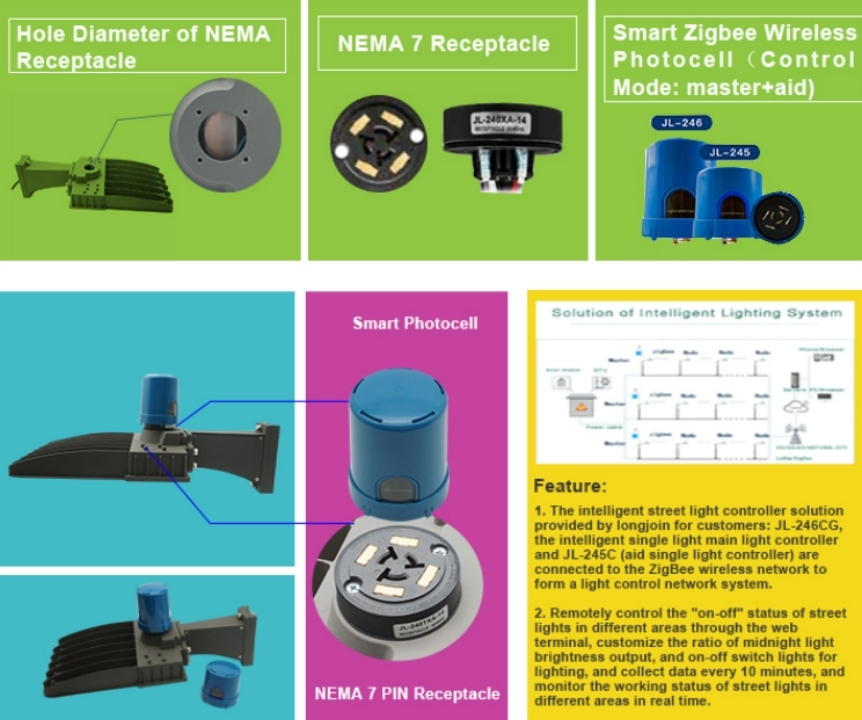Outline
- Introduction
- Current State of Photocell Sensor Technology
- Emerging Trends
- Zigbee
- DALI (Digital Addressable Lighting Interface)
- LoRaWAN (Long Range Wide Area Network)
- Power over Ethernet (PoE)
- Future Developments
- Enhanced adaptive control
- Energy-harvesting capabilities
- Multi-functional integrated systems
- Sustainability and Urban Planning
- Los Angeles
- Copenhagen
- Barcelona
- Economic and Environmental Impact
- Long-term economic benefits
- Environmental impact
- The Bottom Line
Every aspect of a landscape – be it safety, security, or even beauty – relies heavily on outdoor lighting. That’s why its importance cannot be understated. However, one of the most revolutionary changes has come with the use of photocell sensor technology.
This energy-saving and self-operating technology monitors natural light levels and operates street lights in response to them. This is important as it ensures that the lights do not stay on unnecessarily wasting energy and incurring maintenance costs. In this day and age of developments, many municipalities as well as businesses are striving for greener solutions and so this quest for economical and functional novelty putting smart light control options demand on a perpetual rise.
These solutions are not only eco-friendly but also economically beneficial, making them an essential component of modern urban development. As we look ahead, their role will continue to expand, shaping the future of outdoor lighting.

Current State of Photocell Sensor Technology
Outdoor light photocell sensors are widely applied, particularly in streetlights, parking lots, and public areas. These systems rely on light-sensitive sensors to automatically turn lights on at dusk and off at dawn, minimizing human intervention.
While photocell sensors have made outdoor lighting more energy-efficient, current implementations have limitations. Some sensors struggle with precise light detection in variable weather conditions, leading to premature activation or deactivation. Additionally, these basic light switches lack integration with advanced control systems, limiting their responsiveness to real-time data.
Energy efficiency remains a crucial driver for modern lighting systems. Photocell sensors optimize power usage by minimizing operational hours and reducing carbon footprints. When integrated with LED lights, they enhance overall sustainability, as LEDs consume less energy and last longer. Despite the limitations, photo technology forms the foundation of smart, eco-friendly urban lighting solutions today.
Emerging Trends
The integration of smart technologies is reshaping the future of outdoor lighting. One of the most transformative trends is the incorporation of IoT capabilities, enabling these light sensors to connect with broader smart city infrastructures.
Below are some most commonly used setups in this regard.
Zigbee
Zigbee is a low-power, wireless communication protocol. It is designed for IoT applications, including smart lighting. When integrated with photocell sensors, this creates a mesh network where each light communicates with its neighbors.
DALI (Digital Addressable Lighting Interface)
DALI is a commonly adopted protocol for the digital regulation of lighting, including systems with incorporated photocell sensors. In contrast to the published interfaces on the market, DALI allows every individual light fitting to be adjusted or switched on clearly.
Integrated with DALI, these receptacles can send precise commands to adjust lighting levels. This makes them ideal for applications requiring fine-tuned control.
LoRaWAN (Long Range Wide Area Network)
For setups that need a system with long-range capabilities and low power consumption, LoRaWAN could be a good option. When applied to outdoor lighting, LoRaWAN allows city-wide control of lighting systems over large distances with minimal infrastructure.
This protocol particularly suits smart city deployments, where centralized control units can manage lighting across vast areas.
Power over Ethernet (PoE)
Power over Ethernet allows both power and data transmission over a single cable. PoE photocell sensors can be deployed in areas where traditional electrical infrastructure is lacking, simplifying installation and reducing costs.
These devices, when connected to the internet, enable monitoring and controlling of light usage in real-time and, therefore, cater to every change in traffic, weather, and human presence.
Cities can use this technology to schedule when the lighting turns on or off and can also adjust the brightness of the lights using real-time information leading to enhanced energy management and safety for the citizens.

Future Developments
The future of smart lighting technology is set to see significant advancements in both functionality and integration. Here is a brief overview.
Enhanced adaptive control
Next-generation photocell sensors are expected to feature more advanced algorithms that can dynamically adjust lighting levels based on more than just ambient light. For example, future systems will incorporate motion detection, temperature, and even noise levels to fine-tune illumination.
This approach will not only optimize lighting for energy efficiency but also improve public safety and the user experience in various environments.
Energy-harvesting capabilities
Photocell sensors could be equipped with small photovoltaic cells that generate energy during daylight. This power can be stored and can be utilized later on. This would allow streetlights or outdoor fixtures to operate more autonomously. Additionally, their dependence on external power sources will be reduced resulting in energy consumption.
Energy harvesting could be especially valuable in remote areas or developing regions where access to electricity is limited.
Multi-functional integrated systems
Future photocell sensors-based lighting systems could combine lighting, surveillance, and communication technologies in a single unit. Such systems would be able to illuminate streets while simultaneously acting as security cameras or communication hubs, transmitting real-time data through IoT networks.
This multi-purpose functionality could prove vital for smart city infrastructures, enabling local governments to deploy fewer devices while gaining more comprehensive monitoring and control capabilities.
Through this integration, streetlights could evolve into intelligent urban assets, playing a key role in surveillance, traffic management, and environmental sensing.
Sustainability and Urban Planning
Photoecell technology plays a pivotal role in promoting sustainable urban development. By automatically adjusting lighting, it minimizes energy consumption, reducing both operational costs and carbon emissions.
In smart cities, this functionality is integrated with broader energy-saving initiatives, aligning with sustainability goals. Photocell sensors-controlled lighting systems also reduce light pollution, enhancing the quality of life for urban residents by preserving natural nighttime environments while ensuring safety.
Cities around the world are already adopting these cutting-edge technologies to drive these benefits. Here are some real-life case studies:

Los Angeles
This city has implemented smart streetlights equipped with automatic switiching. The results are a 64% reduction in energy consumption.
Copenhagen
Copenhagen is another leader, where the city integrates photo-controlled streetlights. This system has helped Copenhagen reduce its public lighting costs by 50% while enhancing sustainability.
Barcelona
Barcelona has embedded photocell sensors into its smart grid, allowing the city to optimize public lighting while supporting other smart infrastructure projects like traffic and environmental monitoring.
Economic and Environmental Impact
Long-term economic benefits
By optimizing energy consumption, photocell sensors dramatically lower electricity bills for municipalities. Studies show that sensor-equipped LED lighting can reduce energy usage by 30-60%, depending on the system’s configuration and integration with other smart technologies.
Reduced operational hours translate to lower maintenance costs as the lifespan of lighting fixtures is extended. With less frequent need for replacements or repairs, cities can save on both labor and material costs.
Environmental impact
Smart light control systems contribute to substantial carbon emission reductions by curbing energy waste. By only illuminating areas when needed, these systems limit light pollution, conserving ecosystems that depend on natural lighting cycles.
For instance, photocell sensors-integrated smart lighting in Europe has been estimated to cut public lighting energy use by over 50%, significantly contributing to national sustainability goals. In addition, by enabling dimming capabilities and using real-time data, they support a greener, more responsive urban infrastructure.
The Bottom Line
Photocell sensor technology is driving the future of sustainable, efficient outdoor lighting, offering cities improved energy management, cost savings, and environmental benefits. For reliable, innovative photocell sensors, Chi-Swear stands as a trusted supplier, providing high-quality solutions tailored to modern lighting needs.
External Links
- https://en.wikipedia.org/wiki/Zigbee
- https://en.wikipedia.org/wiki/Digital_Addressable_Lighting_Interface
- https://www.emnify.com/iot-glossary/lorawan
- https://en.wikipedia.org/wiki/Power_over_Ethernet
- https://lalights.lacity.org/connected-infrastructure/led_program.html
- https://www.construction21.org/infrastructure/h/smart-sustainable-and-economical-lighting-in-copenhagen.html
- https://ajuntament.barcelona.cat/ecologiaurbana/en/services/the-city-works/maintenance-of-public-areas/energy-management/street-lighting-management






